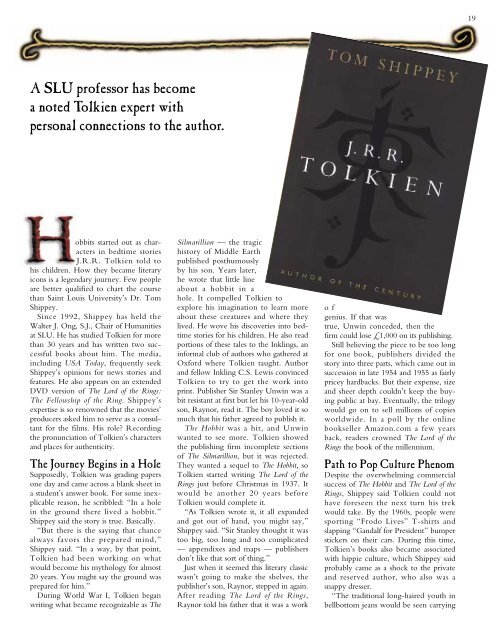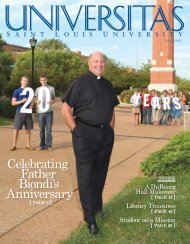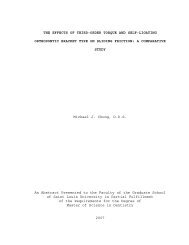Create successful ePaper yourself
Turn your PDF publications into a flip-book with our unique Google optimized e-Paper software.
A SLU professor has become<br />
a noted Tolkien expert with<br />
personal connections to the author.<br />
obbits started out as characters<br />
in bedtime stories<br />
J.R.R. Tolkien told to<br />
his children. How they became literary<br />
icons is a legendary journey. Few people<br />
are better qualified to chart the course<br />
than <strong>Saint</strong> <strong>Louis</strong> <strong>University</strong>’s Dr. Tom<br />
Shippey.<br />
Since 1992, Shippey has held the<br />
Walter J. Ong, S.J., Chair of Humanities<br />
at SLU. He has studied Tolkien for more<br />
than 30 years and has written two successful<br />
books about him. The media,<br />
including USA Today, frequently seek<br />
Shippey’s opinions for news stories and<br />
features. He also appears on an extended<br />
DVD version of The Lord of the Rings:<br />
The Fellowship of the Ring. Shippey’s<br />
expertise is so renowned that the movies’<br />
producers asked him to serve as a consultant<br />
for the films. His role? Recording<br />
the pronunciation of Tolkien’s characters<br />
and places for authenticity.<br />
The Journey Begins in a Hole<br />
Supposedly, Tolkien was grading papers<br />
one day and came across a blank sheet in<br />
a student’s answer book. For some inexplicable<br />
reason, he scribbled: “In a hole<br />
in the ground there lived a hobbit.”<br />
Shippey said the story is true. Basically.<br />
“But there is the saying that chance<br />
always favors the prepared mind,”<br />
Shippey said. “In a way, by that point,<br />
Tolkien had been working on what<br />
would become his mythology for almost<br />
20 years. You might say the ground was<br />
prepared for him.”<br />
During World War I, Tolkien began<br />
writing what became recognizable as The<br />
Silmarillion — the tragic<br />
history of Middle Earth<br />
published posthumously<br />
by his son. Years later,<br />
he wrote that little line<br />
about a hobbit in a<br />
hole. It compelled Tolkien to<br />
explore his imagination to learn more<br />
about these creatures and where they<br />
lived. He wove his discoveries into bedtime<br />
stories for his children. He also read<br />
portions of these tales to the Inklings, an<br />
informal club of authors who gathered at<br />
Oxford where Tolkien taught. Author<br />
and fellow Inkling C.S. Lewis convinced<br />
Tolkien to try to get the work into<br />
print. Publisher Sir Stanley Unwin was a<br />
bit resistant at first but let his 10-year-old<br />
son, Raynor, read it. The boy loved it so<br />
much that his father agreed to publish it.<br />
The Hobbit was a hit, and Unwin<br />
wanted to see more. Tolkien showed<br />
the publishing firm incomplete sections<br />
of The Silmarillion, but it was rejected.<br />
They wanted a sequel to The Hobbit, so<br />
Tolkien started writing The Lord of the<br />
Rings just before Christmas in 1937. It<br />
would be another 20 years before<br />
Tolkien would complete it.<br />
“As Tolkien wrote it, it all expanded<br />
and got out of hand, you might say,”<br />
Shippey said. “Sir Stanley thought it was<br />
too big, too long and too complicated<br />
— appendixes and maps — publishers<br />
don’t like that sort of thing.”<br />
Just when it seemed this literary classic<br />
wasn’t going to make the shelves, the<br />
publisher’s son, Raynor, stepped in again.<br />
After reading The Lord of the Rings,<br />
Raynor told his father that it was a work<br />
of<br />
genius. If that was<br />
true, Unwin conceded, then the<br />
firm could lose £1,000 on its publishing.<br />
Still believing the piece to be too long<br />
for one book, publishers divided the<br />
story into three parts, which came out in<br />
succession in late 1954 and 1955 as fairly<br />
pricey hardbacks. But their expense, size<br />
and sheer depth couldn’t keep the buying<br />
public at bay. Eventually, the trilogy<br />
would go on to sell millions of copies<br />
worldwide. In a poll by the online<br />
bookseller Amazon.com a few years<br />
back, readers crowned The Lord of the<br />
Rings the book of the millennium.<br />
Path to Pop Culture Phenom<br />
Despite the overwhelming commercial<br />
success of The Hobbit and The Lord of the<br />
Rings, Shippey said Tolkien could not<br />
have foreseen the next turn his trek<br />
would take. By the 1960s, people were<br />
sporting “Frodo Lives” T-shirts and<br />
slapping “Gandalf for President” bumper<br />
stickers on their cars. During this time,<br />
Tolkien’s books also became associated<br />
with hippie culture, which Shippey said<br />
probably came as a shock to the private<br />
and reserved author, who also was a<br />
snappy dresser.<br />
“The traditional long-haired youth in<br />
bellbottom jeans would be seen carrying<br />
19

















